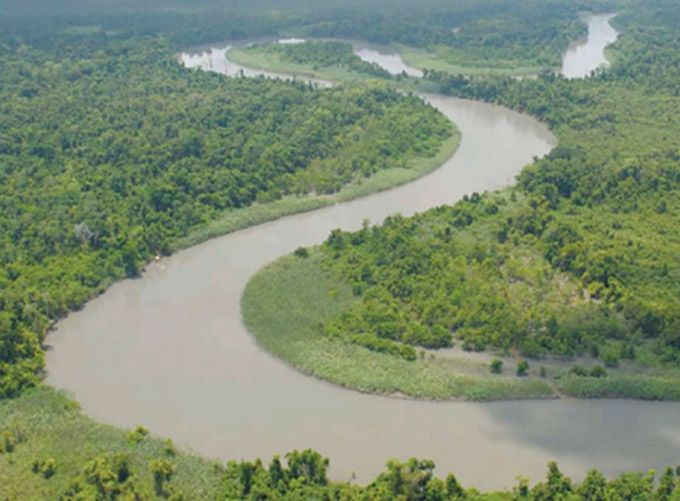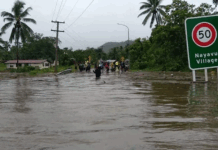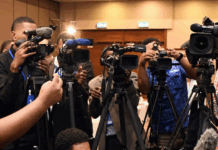
By Jemima Garrett of ABC Pacific Beat
A feasibility study for the first large-scale copper and gold mine in Papua New Guinea’s environmentally-sensitive Sepik River catchment suggests it will be even bigger than expected.
The Sepik is one of the largest wild river systems left in the Asia Pacific region.
The mine owners say they would be using proven best-practice waste and pollution controls but environmentalists say the risk to the pristine Sepik and Frieda Rivers is huge.
The Frieda River Copper and Gold Project is controlled by an 80:20 joint venture between Chinese-owned company PanAust and Australian Stock Exchange-listed junior Highlands Pacific.
“It is important to understand what we have at Frieda River. What we are sitting on is one of the 10 largest undeveloped copper deposits in the world,” said PanAust managing director Fred Hess.
A PanAust announcement said its recently-completed feasibility study outlined a larger scale development than that proposed by previous owner Xstata.
That has scientists and environmentalists worried.
Forested highlands
The Frieda River runs for 100 km from the mine site in the steep, forested highlands before it joins the Sepik which flows another 600 km through a wetland-dotted plain before reaching PNG’s northern coast.
“From a biological perspective I can hardly think of a worse place for a copper mine,” said mammologist Professor Tim Flannery, who made his name in Papua New Guinea identifying 16 mammal species previously unknown to science.
“I spent a decade in that general region doing a faunal survey and was able to show that the mammal faunas in that area were the richest in all of Australasia,” he said.
The feasibility study said the project would build an innovative integrated waste management facility that would see both tailings and waste rock stored underwater.
Monash University environmental engineering senior lecturer Dr Gavin Mudd said integrated management makes sense in that environment but the risks were big.
“The total size of the resource is reported to be about 2.7 billion tonnes. That is just the ore they dig up that has got the copper and gold in it but … there would probably be several billions of tonnes more of waste rock added to that,” Dr Mudd said.
“So it is certainly a very large scale mine and with that … comes very large scale risk,” he said.
Troubled history
In addition, there is concern about the environmental record of mining companies in PNG.
“The history of large mines on rivers in Melanesia is not very good,” Professor Flannery said.
“We’ve had the Bougainville copper mine, tremendous damage to a whole river system. You can go on Google Earth and see it today.
“The Freeport mine in Irian Jaya — again, utter devastation of a river system.
“The Ok Tedi mine and the Fly River — again, you can see the damage done on Google Earth. It is absolutely massive and not denied by anyone,” he said.
PanAust said the design for its integrated waste management facility was world’s best practice and it had a proven track record in similar conditions at its mine in Laos.
“While the pristine environment is there (at Frieda River) we are not looking to disturb that outside of the footprint of the mine,” Hess said.
“The main driver for us is the economic benefit to an enormous number of communities who are deprived of any opportunity to gain better education or medical services because of their subsistence lifestyle,” he said.
Water management
The Frieda River mine site is in a seismically-active region with very high rainfall.
“These will be challenges, along with mineral sulphides, which become unstable when exposed to air and water,” Dr Mudd said.
“Sulphides like that can react with water and with oxygen and then … form sulphuric acid.
“That in turn … dissolves a lot of heavy metals that can sometimes be at concentration thousands or tens of thousands of times greater than the concentrations we know will start to kill fish and algae,” Dr Mudd said.
“It is a very, very serious problem and it is a very widespread issue in the global mining industry.”
PanAust agrees seepage and water management will be a challenge but Hess said the innovative waste management system aimed to properly treat polluted water rather than prevent dam overflow.
Generate hydro-electricity
In fact, the overflow would be used to generate hydro-electricity.
“The aim is to make sure what overflows is of an acceptable quality and meets all of the international standards,” Dr Hess said.
“We have done a lot of modelling … and all of the work that we have done to date suggests that will comfortably allow us to meet the most stringent standards for discharge.”
PanAust’s application for a special mining lease will submitted to the PNG Government before the end of June.
Jemima Garrett is Pacific economics and business reporter for the Australian Broadcasting Corporation (ABC). This article is republished from Radio Australia’s Pacific Beat by permission of the author.







































